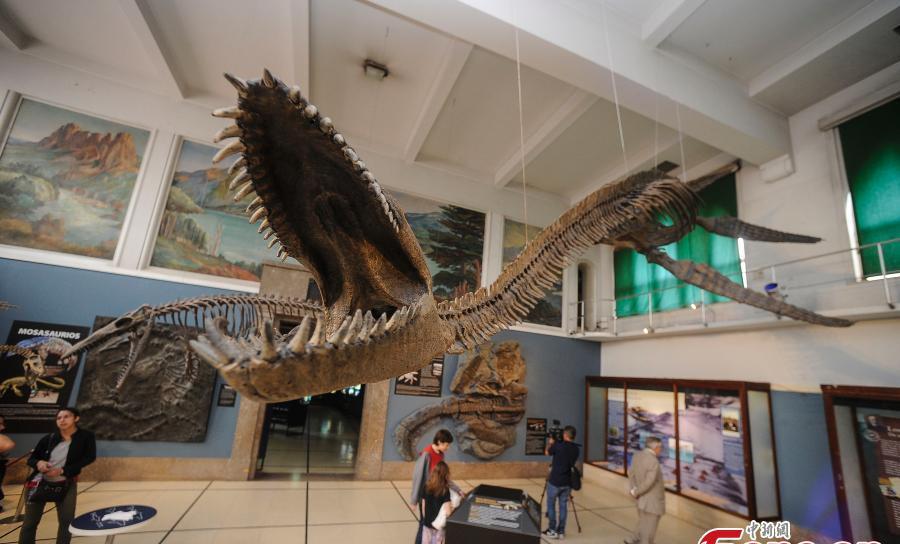2018-12-21 22:03
An ancient monster recently appeared at the Argentine Museum of Natural Sciences.

(A complete fossil skeleton replica of Plesiosaur shown)
The monster is called "Plesiosaurus". It is not drilled from "anomalies" to modern times, as the British drama "Ancient Invasion" says, but by Argentine paleontologist Fernando Novas and his team, fished out of the water.
It is a fossil skeleton. The Novas team was incredibly difficult to dig and fix, and it took 9 years.
<h4>The neck is like a snake, the body is like a turtle</h4>
The Argentine Museum of Natural Sciences in Buenos Aires, founded in 1823.
On display on the 19th of this month is a rare fossil skeleton of a plesiosaur and a replica of its skeleton.
It has a slender neck like a snake, a flat body like a turtle, and a short tail.
This is the most complete fossil of plesiosaur found in Argentina. Novas said the skeleton of the plesiosaur is very clear and is a rare treasure in South America. For world paleontological research, it can help solve the anatomical puzzles related to plesiosaurs in other regions.
The fossil is over 8 meters long and the two fins are 4 meters wide. Novas showed reporters 4 fins in the fossils of plesiosaurs on the 19th, each about 1.3 meters long.
<h4>They once ruled the oceans</h4>
Plesiosaurs were large reptiles of ancient times.
65 million years ago, before the Andes were formed, the vast region of Patagonia was covered by oceans, and there may have been many plesiosaurs that ruled the Jurassic and Cretaceous oceans.
Scientists estimate that an adult plesiosaur weighed 1,000 kilograms. Its long neck stretches and contracts freely, allowing it to flexibly grab a variety of food. Traditional theory is that plesiosaurs ate mainly fish, squid and other swimming animals in the ocean, and later found in fossils that it had clams, crabs and other seafloor shellfish left in its stomach.
How the plesiosaurs acted is debatable. Some say it's like a turtle and a penguin, paddling on its forelimbs; some say it cruises on its forelimbs and uses its hindlimbs when accelerating.
Plesiosaurs are divided into two suborders, Plesiosaurs and Upper Dragons.
Mary Anning, a paleontologist in Dorset, England, was the first to discover plesiosaur fossils in 1821, when she was 22 years old. Mary discovered the first complete ichthyosaur fossil at the age of 12 and the pterosaur fossil at the age of 29. Her findings let people know that living things go extinct.
Since then, plesiosaur fossils have been found several times. In 2006, Norwegian scientists found a fossil animal about 15 meters in the Arctic, believing that it was a dragon that lived 150 million years ago, with a short neck.
Some people once thought that the Scottish "Loch Ness Monster" was a plesiosaur.
<h4>"Get those fossils"</h4>
The site where this plesiosaur was discovered is the coastal area of Lake Argentina in the province of Santa Cruz in southern Argentina.
In the paleontological community, the first person to hear about this plesiosaur was Kenneth La Covara of the University of Rowan in the United States, who is famous for introducing high-tech tools into the field of archaeology and has been studying excavations in the Patagonia region of Argentina for many years. He and his colleagues published a world-famous discovery in 2014, a super-large dinosaur, 26 meters long and weighing 65 tons, named "Shi Dauntless Dragon", one of the largest dinosaurs ever discovered.
He heard about the paleontological fossils of Lake Argentina and went to the site, but he was too busy to excavate. During a coffee break, he told his friend Novas the news and advised him to "fix the fossils."
(Fernando Novas, standing in front of the complete fossil of the plesiosaur.) )
Novas worked at the Argentine Museum of Natural History and was well known in the field of dinosaur research.
It also happened. The guide community in The city of Carrifit near Lake Argentina invited him to give a lecture. He flew over from Buenos Aires, finished his lecture, and asked about fossils.
"They said, yeah, we all know that. We'll go tomorrow. Novas recalled.
<h4>There is also a little tail embedded in the rock</h4>
Came to the lake the next day. Fossil fins and tails are faintly visible underwater.
(At the time of excavation, the plesiosaur encircled a circular embankment in the shallow water where the plesiosaur was located and drained the water.) )
(Before excavations, the tail part of the fossil plesiosaur was clearly visible in the water.) )
Novas called in colleague Marcelo Isas, a paleontologist. Issas took the diving suit and went into the water to find out.
With the consent of the owner, a small team began excavation work in October 2009.
They surrounded the fossils with a dike to drain the water. Then another lake poured in, and they simply poured the water out of the bucket countless times. Because they used an electric hammer to remove the rock, they joked that it was a blessing that they were not electrocuted.
"In short, we are all alive." Novas said lightly.
The whole excavation and restoration work was very long and difficult. The rocks that cover it are very hard, and the fossils are very fragile. In the lab, Novas and his colleagues used hammers and chisels to carefully separate the vertebrae and ribs of the plesiosaur from the rocks.
(The staff loaded the heavy fossils onto a truck and delivered them to the Argentine Museum of Natural History, about 2,737 kilometers away.)
(Paleontologists carefully remove the rock containing the fossil and cover it with a plaster cast to protect it.)
(Novas digs fossils out of rocks in the lab.)
"The tail part is perfect." Novas revealed on the 19th that although part of the tail is still embedded in the rock, they are not scattered and are all in the right place.